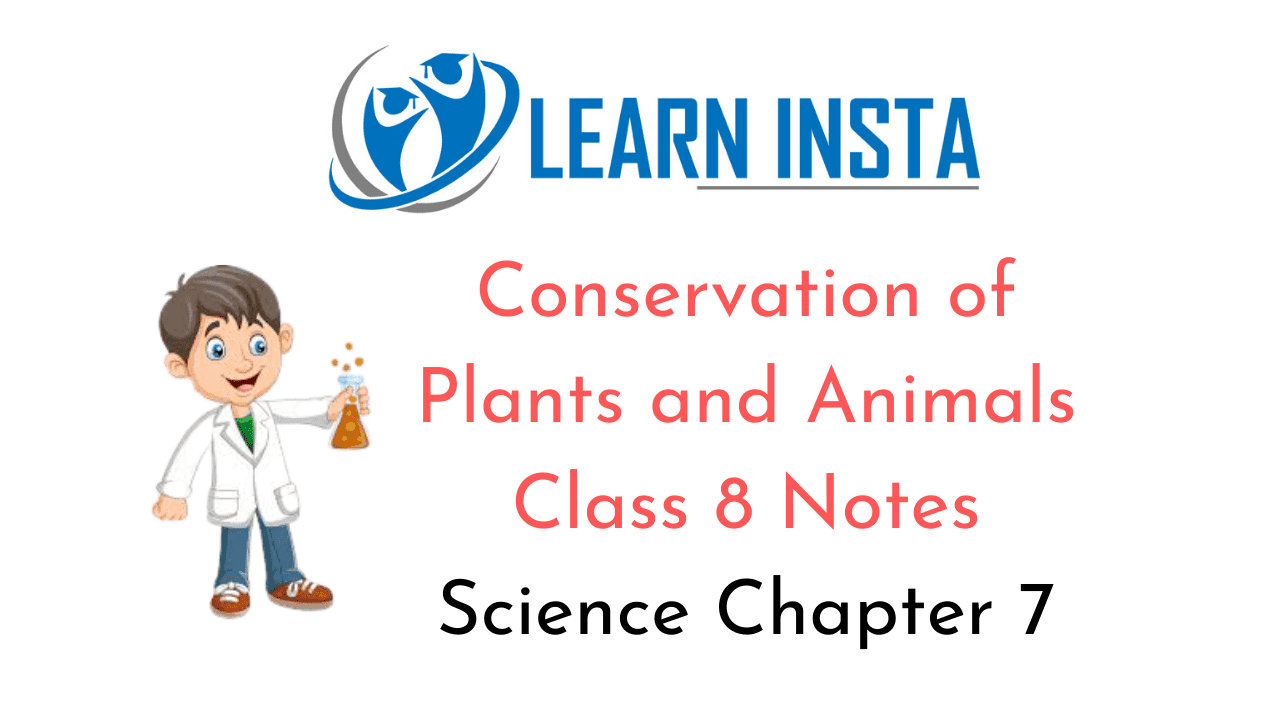
On this page, you will find Conservation of Plants and Animals Class 8 Notes Science Chapter 7 Pdf free download. CBSE NCERT Class 8 Science Notes Chapter 7 Conservation of Plants and Animals will seemingly help them to revise the important concepts in less time.
CBSE Class 8 Science Notes Chapter 7 Conservation of Plants and Animals
Conservation of Plants and Animals Class 8 Notes Understanding the Lesson
1. There are a number of plants and animals that exist on earth.
2. Deforestation means cutting down of forests.
3. The chances of natural calamities like droughts and floods increase due to the deforestation.
4. An ecosystem is made of all the plants, animals and microorganisms in an area along with non-living components such as climate, soil, river, deltas, etc.
5. Plants and animals of a particular area are known as flora and fauna, respectively, of that area.
6. The conversion of fertile lands into deserts is known as desertification.
7. To protect our flora and fauna and their habitats, protected areas called sanctuaries, national parks and biosphere reserves have been earmarked. Activities like plantation, cultivation, grazing, felling trees, hunting and poaching are prohibited there.
8. Biosphere reserves are large areas of protected land for conservation of wildlife, plant and animal resources and traditional life of the tribals living in that area.
9. A sanctuary is an area where animals are kept protected from the disturbances to them and their habitats.
10. National Parks are areas reserved for wildlife where they can freely use the habitats and natural resources.
11. Those species of plants and animals which are found exclusively in a particular area are termed as ‘endemic species’.
12. Species is a group of population which are capable of interbreeding.
13. Project Tiger was launched by the government to protect tigers in the country.
14. Extinct species are those which have disappeared completely from the earth. Example, Dodo and passenger pigeon.
15. Critically endangered species are those which are under highest risk of extinction as their number has decreased drastically. Example, Andean catfish, Abe’s salamander.
16. Endangered animals are those whose numbers are diminishing to such a level that they might face I extinction. Example, great Indian bustard and blue whale.
17. Vulnerable species are those which are most likely to become endangered if not taken care of.
18. Near threatened species are found in small numbers and are scattered all over the world.
19. A sourcebook that keeps a record of all the endangered plants and animals is called ‘Red Data Book’.
20. Migration is the phenomenon of movement of a species from its own habitat to some other habitat for a particular time period every year for a specific purpose like breeding.
21. Reforestation is restocking of the destroyed forests by planting new trees.
Class 8 Science Chapter 7 Notes Important Terms
Biodiversity: It is the variety of different types of plant and animal life in a particular habitat (or in the world as a whole).
Biosphere reserve: A large; protected area of land meant for conserving wildlife, biodiversity, and the traditional lifestyle of the tribal people living in the area is known as a ‘biosphere reserve’.
Deforestation: The cutting down of trees on a large scale is called deforestation.
Desertification: The conversion of fertile lands into deserts is called desertification.
Ecosystem: It is a system formed by the interaction of a community of organisms with their physical environment.
Endangered species: Those species whose numbers are so small that the species are at risk of extinction are called endangered species.
Endemic species: They are the species of plants and animals which are found exclusively in a place.
Extinct animals: Animals which no more exist anywhere on the earth are known as extinct animals.
Fauna: The animals of a particular area are known as fauna of that area.
Flora: They are the plants of a particular area.
Migratory birds: Birds which move from one place to another for some reasons like breeding, climatic changes, etc., are known as migratory birds.
National park: The areas reserved for wildlife where they can freely use the habitats and natural resources are known as national parks.
Red Data Book: A source book that keeps a record of all the endangered animals, plants and other species.
Reforestation: The replanting or restoration of a forest that had been reduced by fire or cutting is called reforestation.
Sanctuary: The area where animals are kept protected from any disturbance to them or their habitat is known as a sanctuary.